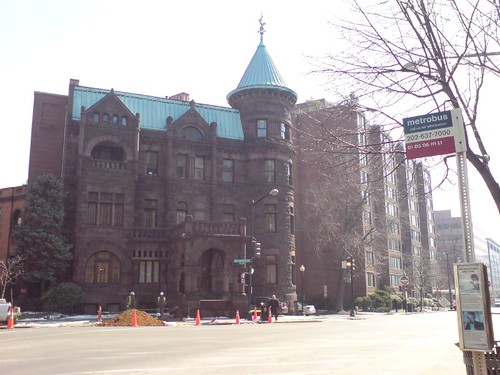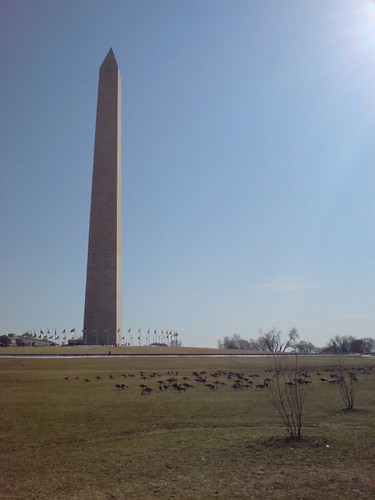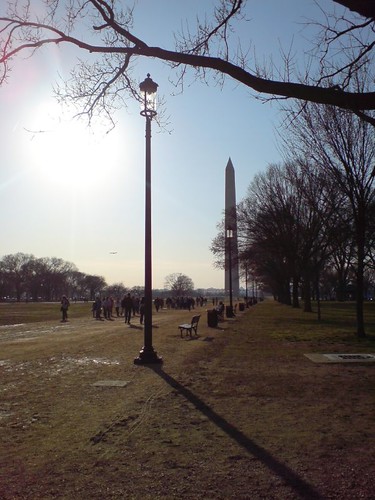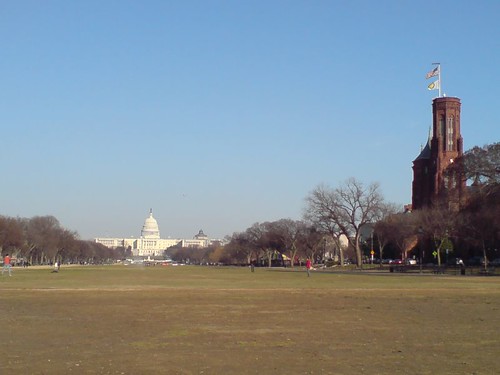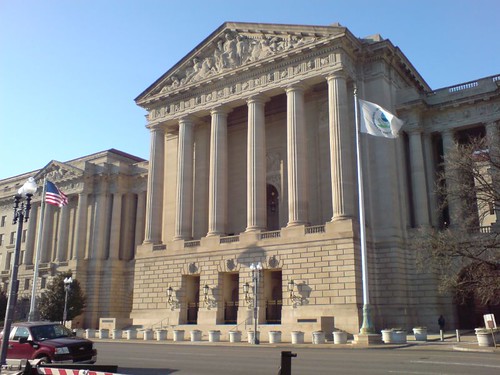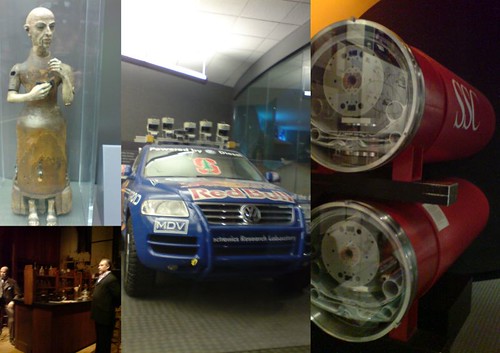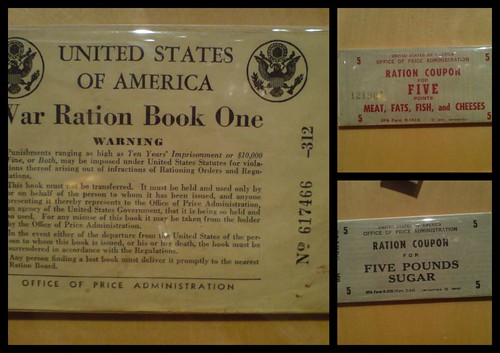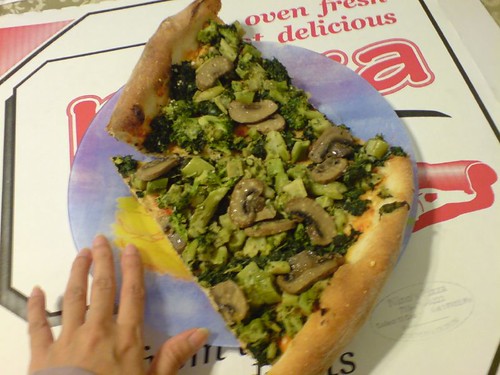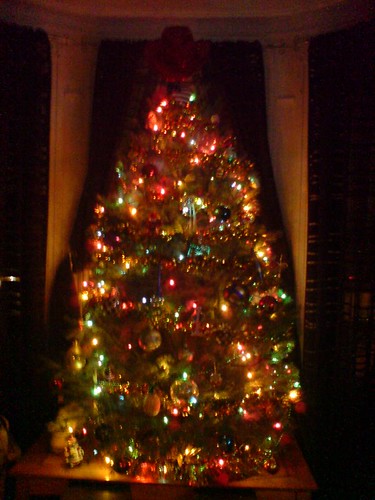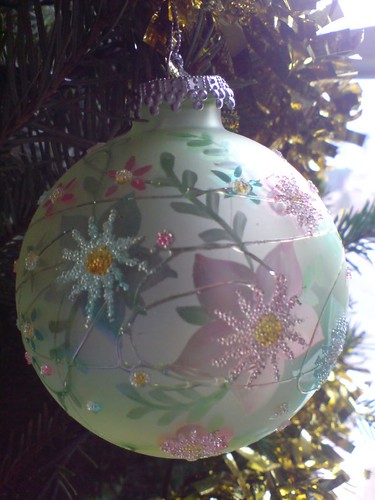Today was very English - grey and overcast, breezy, mild enough to go out with a scarf and gloves but take them off after a few minutes walking.
I walked about 3/4 mile down to Tenleytown to go shopping at Whole Foods, and as I exited the store just the right bus came along. It's possibly my first bus ride since last time I was here (I tend to avoid buses, unfortunately) but as you know from before, they're easy here because the next intersection is usually announced AND they stop every block and a half so you can't really get lost.
Anyway, I've come to realize I need to re-learn a few southern courtesies. I've been working on remembering to smile at people, or how to respond to a neighborly exchange. Well, when I got off the bus, the person in front of me thanked the bus driver, and the person behind me bid her a good evening. As I walked home, I felt as though I'd been remiss, and am now resolved to fix this. I'm trying to remember if people say hello when they get on too.
I am no longer in either London or NYC, that's for sure.
********************************************
Continuing on from the first part, let us move on to two permanent star exhibitions at the NMAH:
First Ladies at the Smithsonian
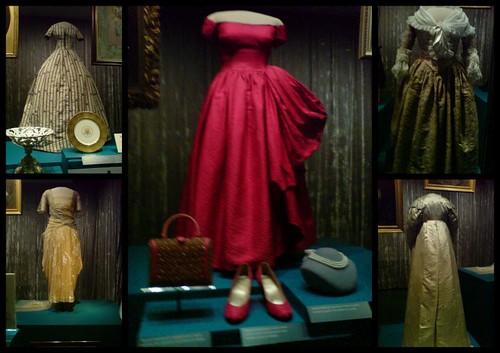

In a case alone, the inaugural gown worn by Helen Taft, 1909
The Star-Spangled Banner


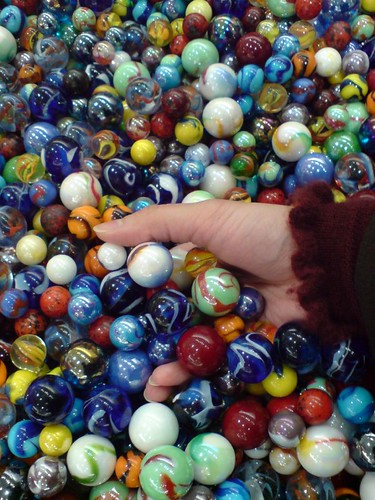
A huge vat of marbles at the museum shop, thus ending on a fun note :)

The ever-popular and changing First Ladies exhibition at the Smithsonian which holds most of the inaugural gowns.
L, top: Mary Lincoln, 1861
L, bottom: Mrs Warren Harding, 1921
Center: Mamie Eisenhower, 1953
R, top: Martha Washington, 1789
R, top: Martha Washington, 1789
R, bottom: Dolly Madison, 1809 (or maybe Mrs James Monroe, 1817?)

In a case alone, the inaugural gown worn by Helen Taft, 1909
The pale yellow Oleg Cassini gown worn by Jacqueline Kennedy in 1961 did not show up so well in my photo. There was also Laura Bush's 2001 fuschia gown. Michelle Obama's has not arrived yet.
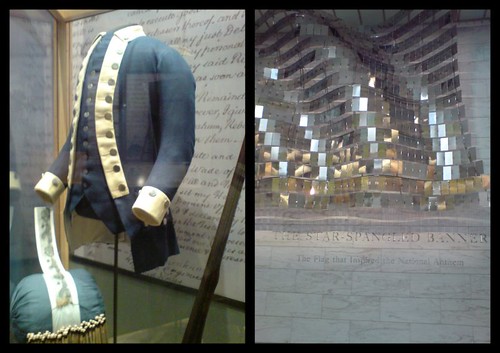

In the center of one exhibition there was a huge Colonial Massachusetts farmhouse in various stages of "undress" from the layers of wallpaper to the mortise and tenon structural joins and ceiling joists. As you walk around the exhibition viewing objects and events occurring during the house's different historical eras, the room setups change to reflect the style of the day. So, for instance, in the Abolition section opposite the Wedgwood "Am I Not a Man and a Brother?" pendants, the house would show the parlor set up in mid-19th century style with the Bible and abolitionist pamphlets on the table.
In our photo above we see a Colonist's evolution into a Revolutionary. An English settler who becomes a Minuteman to fight for his new country. The ribbonlike textile attached to the sleeve is a length of homemade lace, with the bobbins hanging from it.
*********************************
The Star-Spangled Banner
The right side of the above image shows the entrance to the iconic exhibition (no photos allowed), The Star-Spangled Banner: The Flag that Inspired the National Anthem - excellent online exhibition here.
Where do I start with this? It covered the War of 1812, a crucial rite of passage for the young nation seeking credibility and a place on the world political stage.
There was a charred piece of wood from the White House. Here's something I remember from history class. The White House is white because the British tried to burn it down in 1814. After refurbishment, in order to cover up the charring and fire damage it was whitewashed and so it has stayed ever since.
I won't get into the whole story of the war, that could be its own post, except I don't do politics here :)
The Star Spangled Banner, the flag itself, is made of English wool bunting and was sewn by Martha Pickersgill over seven weeks in the summer of 1813 with her daughters and a servant. They were contracted by the Fort and were specialists at making ships' colors and signal flags. At 30 x 42 ft, it was larger than the footprint of the house so the work was moved across the street to a brewery and upon completion was hung on the ramparts of Fort McHenry in Baltimore, Maryland, an important seaport which was the site of the pivotal battle. The British bombarded the port for 25 hours while the Americans throughout the States held their breath.
Francis Scott Key was watching from aboard a ship a few miles distant. As morning arrived he could see the flag still flying and the British ships withdrawing, the United States having withstood the bombardment.
Inspired by the sight of the flag intact in the sunrise, he penned his famous poem.
The flag remained the property of the family for the next 90 years while the song gained in popularity across the nation, but it was displayed at local celebrations. They lent it to the Smithsonian in 1907 and a few years later officially gifted it to the nation. But the Star Spangled Banner did not become the national anthem until 1931. And before the War of 1812, the flag was not the most iconic symbol of this nation but used mostly to identify ships and forts. During the Revolution 30 years earlier, the major symbols were the eagle and lady Liberty.
The flag is now 10 feet shorter and missing one star, owing to the family giving out cuttings to keepsake collectors, and thus it remains. After a major painstaking preservation and reinforcement project in the late 1990s, it has been held in a special climate-controlled protective display chamber and tilted at a 10-degree angle for both support and visibility.
The most amazing technological feature at the exhibit is the giant interactive table onto which is projected the flag in movable sections, with point and click info boxes. Almost like the Microsoft Touch table. Another fantastic interactive flag is available here.
I was quite touched to imagine how Key must have felt seeing that flag still flying in the morning, and penning his four inspired verses.
O say can you see, by the dawn’s early light,
What so proudly we hail’d at the twilight’s last gleaming,
Whose broad stripes and bright stars through the perilous fight
O’er the ramparts we watch’d were so gallantly streaming?
And the rocket’s red glare, the bombs bursting in air,
Gave proof through the night that our flag was still there,
O say does that star-spangled banner yet wave
O’er the land of the free and the home of the brave?
What so proudly we hail’d at the twilight’s last gleaming,
Whose broad stripes and bright stars through the perilous fight
O’er the ramparts we watch’d were so gallantly streaming?
And the rocket’s red glare, the bombs bursting in air,
Gave proof through the night that our flag was still there,
O say does that star-spangled banner yet wave
O’er the land of the free and the home of the brave?
[...]
O thus be it ever when freemen shall stand
Between their lov’d home and the war’s desolation!
Blest with vict’ry and peace may the heav’n rescued land
Praise the power that hath made and preserv’d us a nation!
Then conquer we must, when our cause it is just,
And this be our motto - “In God is our trust,”
And the star-spangled banner in triumph shall wave
O’er the land of the free and the home of the brave.
Between their lov’d home and the war’s desolation!
Blest with vict’ry and peace may the heav’n rescued land
Praise the power that hath made and preserv’d us a nation!
Then conquer we must, when our cause it is just,
And this be our motto - “In God is our trust,”
And the star-spangled banner in triumph shall wave
O’er the land of the free and the home of the brave.

Onto lighter things, I bought a pin for the cherry blossom festival. Difficult to read the card, but it says: The National Cherry Blossom Festival is an annual two-week event that celebrates springtime in Washington, DC as well as the 1912 gift of the cherry blossom trees and the enduring friendship between the people of the United States and Japan. (Proceeds go towards the Festival to offer cultural and community-based events that are free and open to the public.)
I also bought a pin of the Great Seal of the United States of America (proceeds go towards the mission of the Smithsonian Institution, "the increase and diffusion of knowledge"). The card says:
"Benjamin Franklin, John Adams, and Thomas Jefferson were given the task of creating a motto and seal for the Nation by the Continental Congress on July 4, 1776. The official seal was finalized on June 20, 1782. The Great Seal features the American bald eagle as its main element, a symbol that represent the American spirit.The Eagle breast is a shield made up of thirteen vertical stripes representing the thirteen original States. The Eagle's claws clutch thirteen arrows in one and an olive branch in the other. The banner in the Eagle's beak is inscribed with E pluribus unum, which means "out of many, one".

A huge vat of marbles at the museum shop, thus ending on a fun note :)
